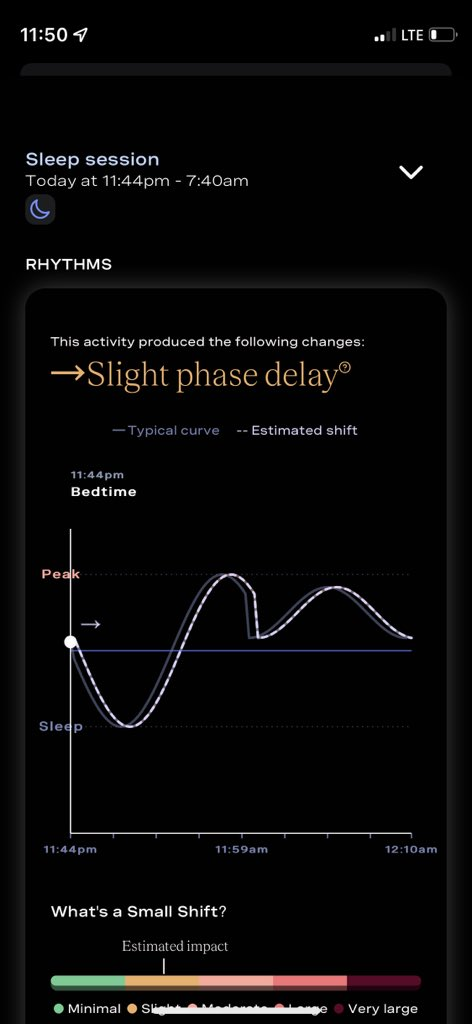Rhythms: A New Feature to Help You Understand Your Daily Rhythms
Crescent's new feature, Rhythms, helps you track and how you’ll feel all day long. It’s part self-awareness builder, part daily planner, and part coaching aid.

Crescent has a new feature called Rhythms that helps you track your body's natural rhythms of sleep, energy, and performance. Use it to see how your actions impact how you'll feel for the rest of the day, and to build stability into your daily life.
What is Rhythms and Why Use It?
We all want to feel better. Less tired, more productive, more focused. If you’re here, you’ve likely identified sleep as a key part of your life to improve. But you often run into an issue: sleep looks “ok”, or is improving, but you still feel tired. In order to help you feel better all day long, we need to look at more than your nights - we need a picture of how you feel 24 hours a day.
Rhythms is a tool that combines wearable data, research in sleep & biological rhythms, and your input to create smart predictions about how you'll feel for the rest of the day. It's a dynamic picture because what you do over the course of each day impacts how you’ll feel in the future. Our goal is for rhythms to help you learn the real-time interaction between your body, your choices, and how you feel, and daily energy patterns you feel and experience throughout the day.
What is feeling energetic, anyways? Energy. Alertness. Motivation. Liveliness. Get-up-and-go. Whatever you call it, it's a key component of our lived experience, and greatly impacts quality of life. But what does it mean from a scientific standpoint?
Many of the physiological underpinnings of an individual’s experience of energy are correlated. That is, they change together throughout the day. These outputs include the central phase of the master circadian clock or SCN, cortisol, dopamine, blood glucose and triglycerides (literal energy sources!).
We designed Rhythms based on research about biological rhythms in these systems. In particular, we looked at studies of how zeitgebers, powerful cues that influence biological timing, impact circadian (daily) and ultradian (within the day) rhythms in the systems that contribute to subjective experience of energy. We turned these studies into rules for how automatically and manually logged activities impact an estimated curve of daily energy - a metric that should match your subjective experience.
How does Rhythms work?

The Rhythms section of an event shows a prediction of how you will feel all day long and the shift from your historical baseline, starting at last night's bedtime. Energy typically has at least a few peaks and valleys throughout the day. The peaks (high points on the graph) are when you have the most get-up-and-go. The valleys (low points on the graph) are when you’ll be feeling calm, or potentially sluggish and sleepy. The very lowest points on the graph occur during asleep. The shape of this curve is determined by when you went to sleep and woke up, how well you slept, and your historical activity patterns. We suggest you check this curve in the morning when you sync your sleep data in order to get an estimate for what you can expect throughout the day.
Use Rhythms to help decide the “when” of your day. When should you go to sleep? When should you put a hard stop on caffeine? When is the best time for you to work out? When is a good time for a snack?
You might want to plan workouts, intense meetings, and the start of deep work for energy peaks. Conversely, you might want to plan meals, naps, and light work for energy valleys.
We encourage you to log 4 main event types:
1) movement (e.g., exercise) if it isn’t already automatically shared with Crescent via your wearable device
2) sleep (this should be automatically shared with Crescent via your wearable - but not all wearables automatically track naps)
3) food
4) light (bright light exposure either from the sun, or a bright screen/lightbulb)
You can use “other” for anything else you might want to keep track of. Don’t forget to add the start and end time of each event you log.
To understand how logging events can help you understand the relationship between your actions and your experience, let's use an example. Imagine you wake up a bit earlier than usual and immediately get some bright sunlight. You add log light as an event, choose a start and end time for your light exposure, and hit save.
Rhythms will incorporate this information to predict an estimated impact on your rhythms for the rest of the day.
Impacts can be broken down into a few simple main categories. Events can move your rhythms for the rest of the day:
- Up or down, indicating a boost or a dip, respectively, in how you'll feel in the short term.
- Left or right. Left indicates an "advance", meaning that you will experience the rest of your ups and downs either sooner (including when you’ll get sleepy for bed!). Right indicates a "delay", meaning that you will experience the rest of your ups and downs later (an indication that an activity might keep you up late tonight).
- Future versions of this feature will have more advanced impacts, so stay tuned.
Summary
Rhythms is a tool that predicts how you’ll feel across the day, starting with last night’s sleep and ending when you go to sleep tonight. You can use this base curve to help align how you feel with what you need to get done. Adding Events lets you associate your actions with impacts on how you feel - and can help you decide if you really want to take that action. Once you save an event, you’ll see the impact of that event on the rest of your day (displayed as energy boosts (up), drops (down), left movement (advance), right movement (delays).
What do I WANT my energy to look like today?
Our bodies did not evolve to operate at 100% all day and all night long. No matter who you are - a short sleeper, a super-athlete, a CEO, an artist, a student - your body needs to trade off between periods of activity and periods of rest. Everyone needs sleep and wake: a very low energy period of unconsciousness (preferably during the night), and a higher energy period of activity and refueling during the day.
Beyond that, there is a great deal of flexibility in how energy can look throughout the day. There is no single “optimal” energy curve for the population, and even one person’s optimal energy curve will change based on what they need to do during a given day, season, or time of life.
For example, different people are predisposed to different numbers and timing of energy peaks and valleys throughout the day. You might have an energy peak in the late morning and early evening, whereas a friend might have two energy peaks in the morning, and two more in the afternoon. These differences depend on many factors, including sex, age, fertility, culture and meal habits, exercise, and disposition.
The better you understand your current timing and number of energy peaks and valleys, as well as how high your highs are (bouncing off the walls? Grogging through the day?) and how low your lows are (calm and focused? Falling asleep at your desk?), the more effectively you can collaborate with your coach to bring your experience into better alignment with your goals.
We suggest that you start by using Rhythms to get a sense of where you are right now, and how you’ve been feeling lately. Then, start to think about how you would design an energy curve to best meet the needs of your day. Want to feel alert when it’s time for dinner with the kids? Put a peak there. Want to schedule in a daily nap? Put a low point there. Want to make sure you’re ready for that 7am workout coming up in a couple days? Now’s the time to draw out your curve and adjust your routine so that when it’s time for you to be “on” (or “off”!), your body is ready.
Our new expert-crafted program, available in the app, Rhythms and Routines, will also guide you through this method of getting to know and work with your body’s rhythms. You can add the program to your schedule from the Explore tab.
If you have feedback on Rhythms, don’t hesitate to tell us by submitting a screenshot via the app, or reaching out to azure@crescent.co, our scientist-in-residence.
